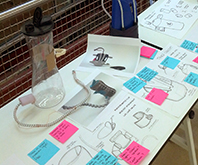Product Design Takes on Drink Aide Project
December 5, 2013
 Health professionals are especially concerned about hydration for physically disabled populations. While most wheelchairs are designed with cup holders, their position and placement often makes the task of drinking fluids difficult for those with little or no upper body movement. To solve this problem, Philadelphia-based health services company Inglis developed Drink-Aide – a patented, hands-free water bottle that attaches to a wheelchair and permits the user to drink independently. Inglis Marketing Director Gary Bramnick, a Drexel LeBow alum, approached our Product Design program to work on improving on the product’s original design.
Health professionals are especially concerned about hydration for physically disabled populations. While most wheelchairs are designed with cup holders, their position and placement often makes the task of drinking fluids difficult for those with little or no upper body movement. To solve this problem, Philadelphia-based health services company Inglis developed Drink-Aide – a patented, hands-free water bottle that attaches to a wheelchair and permits the user to drink independently. Inglis Marketing Director Gary Bramnick, a Drexel LeBow alum, approached our Product Design program to work on improving on the product’s original design.
The Drink-Aide device consists of a FDA-approved 28-ounce water bottle, a vibration resistant flexible drinking tube that resembles a long bendable straw and a universal clamp. The universal clamp fastens the water bottle to a wheelchair, bed or any other accessible location. Bramnick says Inglis was looking for a design that was more convenient and practical for the user.
“Product Design Program Director Mike Glaser and I thought the Drink Aide redesign project would be a beneficial challenge for his Product Design students,” says Bramnick. “In coming up with new concepts, his students had to figure out where to mount it and how to mount it, while keeping disability independence and the fact that most patients with physical disabilities drink a lot of water in mind. The students had to create something that is easy to clean and maintain and practical for every occasion and environment – in the middle of the night, outdoors or even on the go.”
Glaser’s Product Design students began developing concept designs during the fall term. The students then presented drafts, illustrations, 3D models and schematics to Inglis Director of Community Support Services Vicki Cuscino. Their concepts utilized a wide range of materials, clamping devices, shapes and sizes.
“I was very intrigued by some of the ideas that the students came up with that we hadn’t thought of before, such as the use of magnets and simple Velcro straps instead of clamp holders and placing the water bottle on different areas of the wheelchair,” said Cuscino. “Even more impressive was that the designers thought of how to make these designs work in cramped spaces, or if they fall off or are bumped into. Of course, the users are the real experts and they had a lot of good questions for Mike’s students.”
Glaser said the presentation session with Inglis was especially helpful for the students, as they learned more from where their designs went wrong than where they went right. said Glaser. “It’s hard for a student with no physical disability to get into the right mindset and create a design that empowers someone with limited movement ability. The critiques unveiled new and often unexpected questions for the students to answer, ” Glaser reported.
The Product Design program’s final presentations will take place Wednesday, Dec. 11, after which Glaser and his students will let Inglis decide on what idea or ideas they want to pursue.